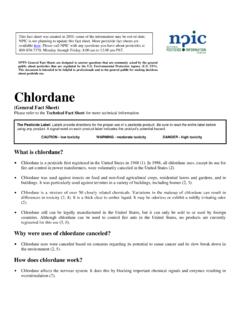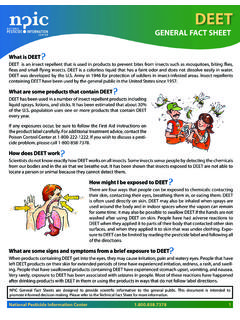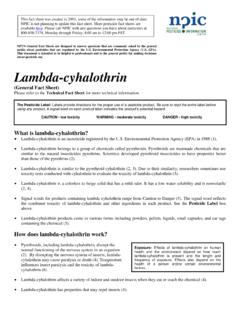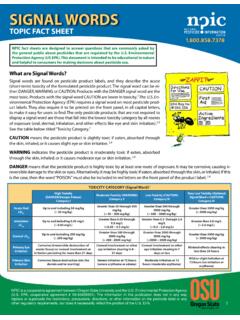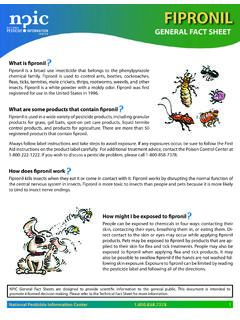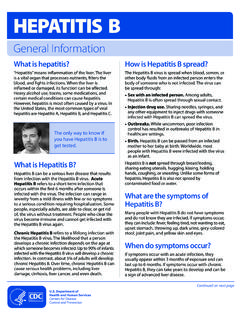Transcription of GENERAL FACT SHEET - npic.orst.edu
1 PYRETHRINS. GENERAL fact SHEET . What are pyrethrins Pyrethrins are pesticides found naturally in some chrysanthemum flowers. They are a mixture of six chemicals that are toxic to insects. Pyrethrins are commonly used to control mosquitoes, fleas, flies, moths, ants, and many other pests. Pyrethrins are generally separated from the flowers. However, they typically contain impurities from the flower. Whole, crushed flowers are known as pyrethrum powder. Pyrethrins have been registered for use in pesticides since the 1950's. They have since been used as models to produce longer lasting chemicals called pyrethroids, which are man-made.
2 What are some products that contain pyrethrins Currently, pyrethrins are found in over 2,000 registered pesticide products. Many of these are used in and around buildings and on crops and ornamental plants. Others are used on certain pets and livestock. Pyrethrins are commonly found in foggers (bug bombs), sprays, dusts and pet shampoos. Some of these products can be used in organic agriculture. Pyrethrins are also found in some head lice products regulated by the Food and Drug Administration. Always follow label instructions and take steps to minimize exposure. If any exposures occur, be sure to follow the First Aid instructions on the product label carefully.
3 For additional treatment advice, contact the Poison Control Center at 1-800-222-1222. If you wish to discuss a pesticide problem, please call 1-800-858-7378. How do pyrethrins work Pyrethrins excite the nervous system of insects that touch or eat it. This quickly leads to paralysis and ultimately their death. Pyrethrins are often mixed with another chemical to increase their effect. This second chemical is known as a synergist. How might I be exposed to pyrethrins Exposure can occur if you breathe it in, get it on your skin or eyes, or eat it. For example, exposure can occur while applying sprays or dusts during windy conditions.
4 This can also happen if you apply a product in a room that is not well ventilated. People using foggers may be exposed, especially if they come back too early or fail to ventilate properly. Exposure can also occur if you use a pet shampoo without wearing gloves. You can limit your exposure and reduce your risk by carefully following the label instructions. National Pesticide Information Center 1. PYRETHRINS. What are some signs and symptoms from a brief exposure to pyrethrins In GENERAL , pyrethrins are low in toxicity to people and other mammals. However, if it gets on your skin, it can be irritating.
5 It can also cause tingling or numbness at the site of contact. Children who have gotten lice shampoo containing pyrethrins in their eyes have experienced irritation, tearing, burns, scratches to the eye, and blurred vision. When inhaled, irritation of the respiratory passages, runny nose, coughing, difficulty breathing, vomiting and diarrhea have been reported. Dogs fed extremely large doses of pyrethrins have experienced drooling, tremors, uncoordinated movement, and difficulty breathing. Increased activity, exhaustion, convulsions, and seizures have also been reported with high doses. When exposed to pyrethrins, people have reported some of the same symptoms that are associated with asthma.
6 These include wheeze, cough, difficulty breathing, and irritation of the airways. However, research has not found a link between exposure to pyrethrins and the development of asthma or allergies. What happens to pyrethrins when they enter the body When eaten or inhaled, pyrethrins are absorbed into the body. However, they are absorbed poorly by skin contact. Once inside, they are rapidly broken down into inactive products and are removed from the body. In a study with mice, more than 85 percent left the body in feces or urine within two days. Removal of pyrethrin 1, a major component of pyrethrins, from goats and hens was also very rapid.
7 However, studies have found very small amounts in the milk and eggs of exposed animals. Are pyrethrins likely to contribute to the development of cancer In two studies, mice and rats were fed low to high doses daily for to 2 years. At the highest dose, some rats had an increased number of liver tumors. However, the changes in the liver leading to tumors only occurred above a certain threshold. Based on these studies, the EPA has classified pyrethrins as not likely to cause cancer. However, this rating is limited to doses below this threshold. National Pesticide Information Center 2. PYRETHRINS. GENERAL fact SHEET .
8 Has anyone studied non-cancer effects from long-term exposure to pyrethrins In separate studies, rats and dogs were fed low to moderate daily doses of pyrethrins for one to two years. At moderate doses, there were effects to the thyroid in rats and the liver in dogs. In another study, rats breathed in low to moderate doses daily for several months. At low doses, damage to tissue along the nasal and respiratory passages was observed. At moderate doses, lower body weights, difficulty breathing, and tremors were observed. Scientists have also tested whether pyrethrins cause developmental or reproductive effects in rats and rabbits.
9 In these studies, animals were fed low to moderate doses daily throughout their lives or during their pregnancies. Effects were only observed at moderate doses. These included lower body weights in some adult rats and their young. Drooling, unusual postures, and difficulty breathing were observed in one adult rabbit. Also, two rabbits lost their pregnancies. However, it is unclear if the lost pregnancies were related to pyrethrins. No effects were observed in rats or their young when fed solely during their pregnancies. Are children more sensitive to pyrethrins than adults Children may be especially sensitive to pesticides compared to adults.
10 However, there are currently no conclusive data showing that children have increased sensitivity specifically to pyrethrins. What happens to pyrethrins in the environment In the presence of sunlight, pyrethrin 1, a component of pyrethrins, breaks down rapidly in water and on soil and plant surfaces. Half-lives are hours in water and hours on soil surfaces. On potato and tomato leaves, less than 3% remained after 5 days. Pyrethrins do not readily spread within plants. In the absence of light, pyrethrin 1 breaks down more slowly in water. Half- lives of 14 to 17 days have been reported. When water was more acidic, pyrethrin 1 did not readily break down.
